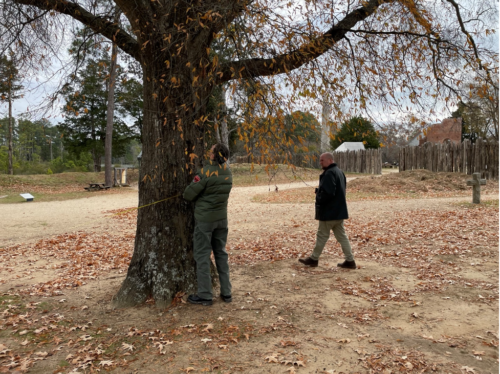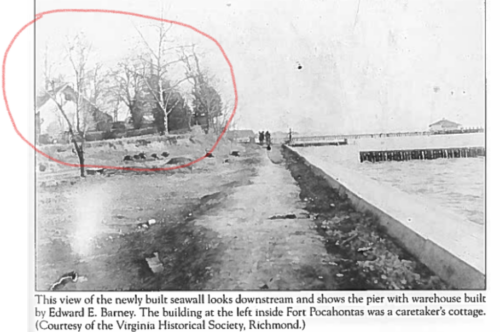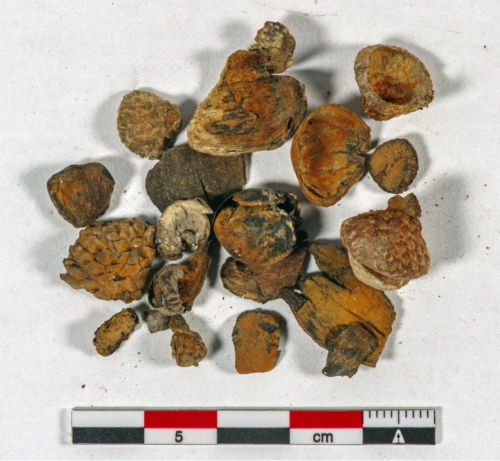Which Settled First: the Oak or the Acorn?
January 25, 2023 12:56 pm

By Dean Cumbia, Director of Forest Management —
As the site of the first permanent English settlement and a hotbed of activity during the American Revolution and Civil War, Virginia has a rich history. All throughout that history, trees have played a role. Have you ever wondered whether some of the first trees settlers saw when they arrived are still standing? DOF recently tried to find out.
Last December, DOF staff visited Jamestown to meet with staff from Preservation Virginia, the organization that manages Historic Jamestowne in partnership with the National Park Service. The goal was to examine a mature willow oak tree on the historic site to estimate its age and determine if it may descend from oak trees there when English settlers arrived in 1607.
- DOF’s Bryant Bays (left) and Greg Bilyeu (right) examining a willow oak at Jamestown in December 2022.
- Willow oak tree at Jamestown, December 2022.
The first step was to determine the tree’s age. Willow oak is in the red oak group and native to eastern Virginia. The average willow oak lifespan is 100 years, but there are willow oaks in Virginia that have exceeded 200 and even 300 years of age.
Several methods can be used to age live trees, with the most common method being through the use of an increment borer. This tool bores a small hole into the center of the tree and a pencil-sized core sample is removed, allowing the counting of annual rings. This method is generally reliable, but if the tree is rotten or hollow (not uncommon with older trees), a complete sample cannot be gathered. The small hole created in the tree, while in most cases insignificant, could allow a path for decay or staining of the wood. Due to the significance of the oak, the decision was made to use another method to determine its age.
A tree’s size sometimes relates to age, however, there are many variables that affect size and growth rate including soil, moisture and sunlight. Trees that grow in open conditions typically grow faster, are larger in diameter and develop wider crowns.
Jamestown Willow Oak
DOF staff measured the Jamestown willow oak and determined it was 36.4 inches in diameter. Among other trees in a forest, willow oaks grow between 0.26 to 0.40 inches in diameter each year. At these rates of growth, a tree of this size could be between 90 and 140 years old.
However, given the oak’s persistent lower limbs and wide-spread, open branches, it’s likely that the tree grew in the open for most of its life. DOF sampling of open grown willow oaks showed a growth rate of 0.80 inches per year, double that of forest oaks. At this growth rate, a 36-inch willow oak could be as little as 45 years old. On the other hand, the Jamestown willow oak is showing some signs of decline, which has likely resulted in a slowed growth rate. These varying factors make it difficult to determine the age of the tree from size alone.
History
Yet another way of aging and learning more about the life of a tree is through examining historic and photographic evidence. Since the original settlement, Jamestown has more or less been in continuous use by various peoples. Trees were cleared from the island for agriculture, fuel and construction of the colonial fort and other structures. Jamestown was also the site of activity during the American Revolution, the War of 1812 and the Civil War. The willow oak of interest is within the perimeter of the earthen fortifications of the Civil War-era fort.
The search started with photographs of Jamestown. Preservation Virginia provided a number of historic photographs, including some aerial photographs from the 1920s that show most of Jamestown was open land, in pasture or some other agricultural use. However, a patch of trees is evident where Fort Pocahontas and the old church are. Rare photos from around 1901, when the seawall on the river was built, are about the oldest that were located. These pictures show small-to-medium trees in the area.
- Images courtesy of Preservation Virginia
In order to look further back, our investigation turned to historical accounts, as to date, there are no known photographs or newspaper illustrations of Jamestown during the Civil War. In the book, Embattled Shrine: Jamestown During the Civil War, author David Riggs provides details of the Jamestown Island area during Civil War activity. The book includes an account from young Civil War Second Lieutenant Emmett M. Morrison, who was assigned to Fort Pocahontas to train enlistees.
Riggs and Morrison describe the Jamestown Island area: “its flat, barren appearance which is described by Morrison as ‘a perfect desert.’ The soil was sandy and the landscape was devoid of trees. Only as one looked southeastward did a third feature, the Ambler house, rise into view. The house was situated on about an acre of beautiful grass, the only greenery in the area.”
With the degree of construction, war activity, and the military need for unobstructed lines of sight, it’s very unlikely there were any trees within Fort Pocahontas while it was occupied. This means trees in the area are unlikely to pre-date the Civil War activity. But this look into historical accounts allows us to establish the upper maximum age. When the fort was abandoned in 1865, the trees were able to regenerate (as seen in the photos from the 1900s), making the oldest potential age of a present-day tree in the area of the fort 157 years old.
As to how the trees regenerated…chances are, they had some help from birds. Just as squirrels move and transplant acorns with their caching tendencies, birds will carry or eat seeds then later drop or excrete them. Blue jays in particular carry acorns long distances and often successfully establish oaks far from parent trees. This is the likely how present-day trees like the willow oak were able to make a comeback.
Origin of the Jamestown Willow Oak
So far, our investigation has indicated that it is very unlikely the present-day willow oak was alive at the time of the original settlement in 1607. However, if it can be determined that willow oaks were historically present on Jamestown Island, we may learn whether the present-day tree hails from original trees in the area. That’s where the archeologists from Preservation Virginia come in.
In and around Fort Pocahontas are several old wells. The colonial settlement was plagued by lack of a good water supply. Wells were dug, served for a time, then became unusable. After they were abandoned, they became a place to discard refuse and trash. The wells filled naturally with mud, preserving their contents by removing any oxygen and preventing decomposition. This process turned the wells into “muddy time capsules” containing many artifacts from which archeologists have made some great discoveries.
Leah Stricker is an archeologist and curator with Preservation Virginia at Jamestown, specializing in archaeobotany, the study of ancient plant remains. Excavation of the wells yielded various plant parts and materials from approximately 1611-1616. This included walnut shells, hickory nuts, squash, pumpkin rinds, grape seeds and yes… acorns! This indicates that all of these plants occurred during this time period.
DOF staff joined Stricker in examining a number of oak acorns in the collection. These acorns were compared with those collected from the willow oak tree in 2022 and seemed to be a match. Additionally, a leaf from the well collection was positively identified as a willow oak. So, willow oaks were present on Jamestown Island in the early 1600s!
- Ancient acorns removed from a well in Jamestown, c. 1611. Courtesy of Preservation Virginia.
- DOF Director of Forest Management Dean Cumbia looks through acorns removed from the well in Jamestown.
The conclusion
While we cannot definitively identify the present-day Jamestown willow oak in historic photographs, research suggests it may have grown shortly after Civil War activity in Jamestown concluded, meaning it could be up to 157 years old. Our investigation also concluded that since willow oaks were present at the time of settlement, this tree is very likely the descendant of a willow oak growing when settlers first landed in Jamestown in 1607.
This project would not have been possible without support from Preservation Virginia, Jamestowne Rediscovery at Historic Jamestowne, Voorhees Archaearium Museum and the Library of Virginia. DOF welcomes continued conversations around both historical and contemporary trees.
Tags: Genetics, History, Oak, Partnerships
Category: Research






